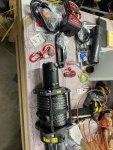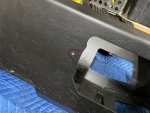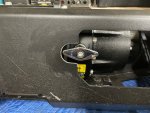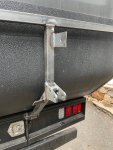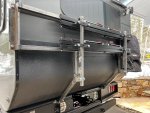Victron battery monitor
They say you don't manage what you don't measure. With 300 amps of lithium, and 600 watts of solar, a 30 amp battery to battery charger, and only camping during Summers, the original owner simply left on the inverter full time (during season), and did not have much need to monitor the battery.
Living and workout out of this rig for more extended periods, some of which won't have the benefit of the sun for perhaps days, and what was once overkill would benefit from a good battery monitor.
The cooktop is a single induction burner, we'll run two refrigerators, and daily use of a Breville espresso machine (yes, we're a little bit spoiled...ok a lot when it comes to coffee), combined with two remote work setups...not a problem in Summer...potentially taxing over days in Winter. We managed just fine with a smaller system (240a lithium/320w solar/25a b2b charger), but only because we were able to monitor and thus manage accordingly.
Once we started using Victron monitors, it is standard fare to have them installed in any rig we own. I find the BMV-700 is adequate for our use with a single battery bank. They make other models for dual banks, and other. We simply haven't had the need to go higher than the 700.
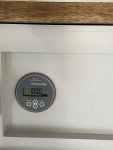
The key to installing these is to have EVERYTHING to/from the battery go through the supplied shunt on the negative side. This way all energy going in our out is counted down to the individual watt.
They are programmable for the size of your battery capacity, the type of battery, and much more. This takes into account how different battery systems charge (some are more efficient than others, or even at different points in their charge cycles), and discharge at various loads so long as you select the correct settings. Example: a sealed lead acid (SLA) or absorbed glass mat (AGM) battery will have a significant loss in efficiency when pulling a high load from them vs. a much lighter load. Lithium are much less affected by this. Victron incorporates Peukert's law into its various algorithms to account for the scenario per your specific battery setup as just described.
It's also nice that you can pair most Victron devices with their VictronConnect app to set, control, and monitor what the various systems are doing. We have ours set up with the inverter, solar charge controller, and will add in this monitor too once we have a free minute. A quick screen shot take from the house to the camper where we were barely in bluetooth range.


They are also very helpful when diagnosing issues, such as a blown fuse, etc. No solar in...check that breaker. Solar in, but not to the battery...check the other breaker. Camper plugged in to shore power, but no A/C coming in...better check the camp sites GFCI to see if it popped. How much sun are we getting today vs. expected...time to go up and clean off some panels maybe? You get the idea.
There are other monitors that use voltage, and they are often inaccurate at best. These are worth the price of admission.
They say you don't manage what you don't measure. With 300 amps of lithium, and 600 watts of solar, a 30 amp battery to battery charger, and only camping during Summers, the original owner simply left on the inverter full time (during season), and did not have much need to monitor the battery.
Living and workout out of this rig for more extended periods, some of which won't have the benefit of the sun for perhaps days, and what was once overkill would benefit from a good battery monitor.
The cooktop is a single induction burner, we'll run two refrigerators, and daily use of a Breville espresso machine (yes, we're a little bit spoiled...ok a lot when it comes to coffee), combined with two remote work setups...not a problem in Summer...potentially taxing over days in Winter. We managed just fine with a smaller system (240a lithium/320w solar/25a b2b charger), but only because we were able to monitor and thus manage accordingly.
Once we started using Victron monitors, it is standard fare to have them installed in any rig we own. I find the BMV-700 is adequate for our use with a single battery bank. They make other models for dual banks, and other. We simply haven't had the need to go higher than the 700.

The key to installing these is to have EVERYTHING to/from the battery go through the supplied shunt on the negative side. This way all energy going in our out is counted down to the individual watt.
They are programmable for the size of your battery capacity, the type of battery, and much more. This takes into account how different battery systems charge (some are more efficient than others, or even at different points in their charge cycles), and discharge at various loads so long as you select the correct settings. Example: a sealed lead acid (SLA) or absorbed glass mat (AGM) battery will have a significant loss in efficiency when pulling a high load from them vs. a much lighter load. Lithium are much less affected by this. Victron incorporates Peukert's law into its various algorithms to account for the scenario per your specific battery setup as just described.
It's also nice that you can pair most Victron devices with their VictronConnect app to set, control, and monitor what the various systems are doing. We have ours set up with the inverter, solar charge controller, and will add in this monitor too once we have a free minute. A quick screen shot take from the house to the camper where we were barely in bluetooth range.


They are also very helpful when diagnosing issues, such as a blown fuse, etc. No solar in...check that breaker. Solar in, but not to the battery...check the other breaker. Camper plugged in to shore power, but no A/C coming in...better check the camp sites GFCI to see if it popped. How much sun are we getting today vs. expected...time to go up and clean off some panels maybe? You get the idea.
There are other monitors that use voltage, and they are often inaccurate at best. These are worth the price of admission.
Last edited:




